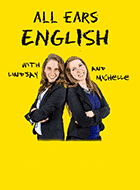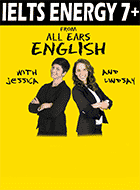Have you ever sent an email to the wrong person?
Have you ever sent an email in English and immediately regretted it?
There are so many different mistakes that can be made in written communication.
We’re going to look at the best ways to ensure that your written communication is as sophisticated and proper as possible.
As a reminder, we have Aubrey here for a grammar series.
This is the second post in her series, as we talked a few weeks ago about making sure your sentences aren’t too simple in a presentation.
This is how to create the very best communications to help set you apart as a more advanced English speaker.
Get Your Transcripts Today!

Make sure you understand every word you hear on All Ears English.
Bring your English to the advanced level with new vocabulary and natural expressions.
Subscribe and get the transcripts delivered by email.
Learn to speak naturally with the American accent.
Click here to subscribe and save 50%
Typical Problem With Business Correspondence
If you’ve ever sent an email to the wrong person, then you know how embarrassing this can be.
We’ve all made mistakes when it comes to sending out communication, particularly in the workplace.
As you are working to become more experienced with English, you are going to make mistakes in the workplace.
You are going to have frustrations and challenges, and you will ultimately send out communication that isn’t your best or intended for a given audience.
You live and learn from these mistakes, and there are plenty of them that you may experience particularly in the workplace.
It can be disastrous when sending business emails to accidentally share highly sensitive information with the wrong person.
Today we’re going to talk about another problem we face when composing business correspondence, and that is called parallel structure.
Simply put, parallel structure is making everything in a sentence match.
There’s much more to this of course, but this is a really important topic to cover.
You will come to understand what parallel structure is, what it means, and how you can be sure to focus on this in your communication.
Why Is This Important?
So why is it so important to use parallel structure?
You want to write emails and communication that are concise, to the point, and full of useful information.
A big part of this is to use something like parallel structure because it helps your communication to look polished.
It’s vital to use parallel structure in all conversation and writing, but we’re focusing on business emails today.
This is because so much of our communication at work these days is through email, especially right now with coronavirus!
If you’re not using parallel structure, your language level appears lower and less sophisticated.
This isn’t what you want as you’re working so hard to become stronger in English!
You also run the risk of colleagues taking your emails less seriously, or ignoring them entirely.
Though simple mistakes happen all the time in email communication, if you can focus on something like parallel structure it helps you so much in the long run.
The fact is that how you write says everything about you, especially when this is your primary type of communication.
When you are communicating in this way, the other person can’t see your face or hear your knowledgeable tone of voice.
You want to communicate successfully, especially in written communication in your job.
This is one way of doing that, and so you will understand exactly how this works.
Understanding Parallel Structure
So what is parallel structure?
We’ve already said that this is about making everything in a sentence match–but what exactly does that mean?
Let’s look at a couple of examples so that you can see this at work.
We’d say, “a desk and a pencil” instead of “a desk and the pencil”.
We’d say “I feel excited, happy and nervous,” not “I feel excited, happy and am feeling nervous.”
This means that you are using the same grammar pattern or structure on both sides of certain linking words.
So in the examples above you can see that adding another word is unnecessary.
You can see that you want to keep the sentence uniform with the same pattern or structure.
It should all fit and align and work in the same sort of way throughout the sentence.
This not only makes our sentences grammatically accurate, but it sounds much better and more polished.
You can clearly tell when the sentence is following this same pattern, and a good way to test it is to read it out loud.
There are a lot of complex rules about parallel structure, but today we will teach you the two main ones.
Parallel Structure In A Series of Two Or More
The first one we’ll look at to help you understand this is parallel structure in a series of two or more.
On either side of a conjunction, you need matching grammar forms.
Let’s compare and contrast the wrong way and then the right way, so that you can understand how this works.
You will come to understand which way is wrong and why, and then what the right way is to communicate such a thought.
- The Wrong Way: “We must plan an exceptional event, yet the budget.” This is a perfect example, because it’s as if the thought isn’t finished yet. It may make sense in the writers mind, but you can’t understand what they mean in written communication. Like the thought isn’t finished, even though it might make sense in the writer’s mind. Why is it wrong? It has a verb phrase before yet and a noun after. It just doesn’t work in this way and it comes across as incomplete.
- The Right Way: “We must plan an exceptional event, yet stay within the budget.” The statement is complete, it uses parallel structure, and it works well as a written communication. You can understand the writers thought process and what they are trying to convey. It may seem like a simple tweak, but it’s an important one. That one small change helps this to be a polished, complete, and accurate statement.
This one is, but a statement can be finished and not have parallel structure.
Let’s look at an example like that.
The items in a series can be adjectives, nouns, verbs, phrases or clauses.
They should be grouped together– but remember that nouns should be grouped with nouns and verbs should be grouped with verbs.
For example, when a sentence contains a series of verbs, don’t mix grammar forms.
You wouldn’t want to take an infinitive like ‘to work’ and a gerund, such as ‘typing’.
- The Wrong Way: “Those attending the training learned how to negotiate, network and communicating for the best outcome.” This is a finished statement, but what’s before and after the conjunction doesn’t match. When we look at it we have infinities – to negotiate, to network and then the gerund communicating. The grammar forms don’t match, and you can see “communicating” stand out as incorrect here. So it’s really about matching, and what comes after “how to” must match.
- The Right Way: “Those attending the training learned how to negotiate, network and communicate for the best outcome.” You can see that this works and that it is correct. You can even test this by reading it out loud to yourself, and you can feel that it flows better this way. Remember it’s all about matching, and that will help you to stay on track.
Looking At Correlative Conjunctions or Paired Conjunctions
Then there is the instance where you have correlative conjunctions or paired conjunctions.
An example of this might be “both…and” / “not only…but also.”
Let’s look at examples of this so you can see how it would work in conversation.
- The Wrong Way: In this example you’re emailing instructions for a brainstorm that team members should be working on together. “We are trying to come up with a logo that is both a picture and easy to understand.” After “both” we have a noun (a picture) and after “and” we have an adjective phrase “easy to understand.” We need an adjective phrase after “both” and after “and” to have parallel structure. This is a bit more subtle so it’s not as easy to identify right away.
- The Right Way: “We are trying to come up with a logo that is both full of color and easy to understand.” This addresses things properly. It ties everything together in a cohesive way. You can see how this one simple change makes such a big difference in the communication.
Let’s look at another example of this so you can see it at work.
- The Wrong Way: “When planning the presentation, consider not only your topic but also presenting it well.” What is wrong here? The noun after “not only” and then the verb after “but also.” You can tell that it doesn’t even flow well, and that’s where the confusion comes in. So while it may not sound bad at first, read it back and you will see where the mistake is.
- The Right Way: “When planning the presentation, consider not only your topic but also your audience.” These are the common mistakes that happen all the time, and you will see them often with other students learning English like you. That one change may seem small, but it makes a big difference.
It’s very impressive when you can structure the sentences together properly.
It helps if you can remember these things and even read things out loud to yourself if you’re in doubt.
If you can try to remember the rules of parallel structure, then you will really be able to focus on the proper ways to communicate.
This helps to take your English up to a higher level, helps you to build confidence, and ensures that your communication is noticed for all the right reasons.
Takeaway
Parallel structure and proper use of linking words/transitions add polish to your work emails.
This shows your coworkers that you are really starting to master the English language.
If you don’t use parallel structure, your emails will sound unsophisticated and rather basic.
You may give off the impression to your co-workers that your language level is lower than it really is.
In the long term, this may cause others to disregard what you are saying–you don’t want your emails to come across as less important than they are.
Try this aspect of English to really take your communication up a notch.
Others will notice and really pay attention to what you have to say, and you will gain confidence along the way.
If you have any questions, please leave them below in the comments section.
We’ll get back to you as soon as we can.








